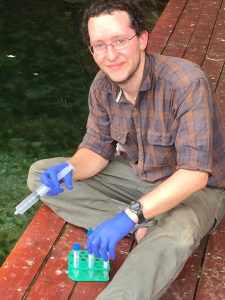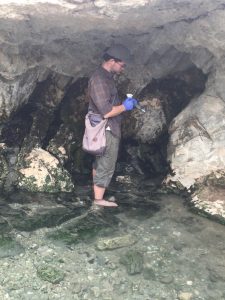
As a microbial ecologist, I study how microscopic organisms like bacteria and fungi drive ecosystem processes at large scales. I am particularly fascinated by the organisms that live in very dry places. Twice a year, I spend a month working in the Namib Desert in western Namibia, one of the driest places on the planet.
Even with annual rainfall less than 1/4 inch in some places, the desert supports an impressive diversity of organisms from tiny bacteria cells to 2000+ year old plants (Welwitschia mirabilis) to massive animals like lions, elephants, and black rhinos. The desert’s hyperaridity (extreme dryness) makes it a fascinating place to understand how microorganisms adapt to and modify their environment under serious environmental stresses. I currently have two major projects in the Namib, both of which I worked on during a recent trip in January.
DECOMPOSING IN A DRY LANDSCAPE
One of my projects involves studying plant litter decomposition in arid lands. As plants decompose, bacteria and fungi convert the plant’s carbon into carbon dioxide that is respired into the air.
Being able to predict how quickly this happens is an important component of climate models but unfortunately, many of these models don’t do a good job predicting CO2 emissions from most deserts.
I have a series of experiments based at the Gobabeb Research and Training Centre (another biological field station) designed to manipulate moisture, microbes, and sunlight to see how these different factors interact with one another to drive plant decomposition in this hyperarid desert.
HOPE SPRINGS ETERNAL
Another project is aimed at studying bacteria that live in groundwater aquifers deep underneath the desert. Although microbes underground make up an enormous proportion of
the total biomass and biodiversity of this planet, we still no very little about them. In January 2018, I took a visit to Namibia’s Kunene region to collect water from several dozen groundwater springs and determine what kind of bacteria live in these environments.
This work is funded by a NASA research fellowship to understand what kinds of organisms might live in similar subsurface environments beneath the arid surfaces of other planets like Mars, but there is also a more down-to-Earth focus for this work. The springs in this region are the only reliable source of water for many large animals in the desert and many are at risk of drying up under warming climates.
If we know which types of microorganisms live in the water that feeds these springs, we can figure out if that water is coming from deep groundwater (that is more stable during dry periods) or from shallower aquifers and recent rainfall (which means the springs will more quickly dry up). Communities can then use this information to make better long-term plans for managing wildlife populations.
WORTHWHILE LONG DAYS
When I only have the chance to be in the field for a few weeks each year, time is very precious. Most days I’m working 10-12 hours collecting plants, repairing equipment, meeting with colleagues, or driving between field sites. It’s exhausting but for me, it sure beats sitting in a dark lab in the Michigan winter.
When I’m working out in the sand dunes, I often do my fieldwork in shorts and bare feet, often with a beer in my pocket to crack open on top of a sand dune at sunset. You’ll never hear me complain about my fieldwork.
MSU’s African Studies Center and KBS both provided funds that allowed me to take this most recent trip and continue to support my ongoing lab work here in Michigan. The springs research is supported by a Graduate Fellowship from the Michigan Space Grant Consortium.
Robert Logan is a graduate student in the Evans Lab at KBS. To learn more about his research and see more photos of his travels, visit his website.




A legacy of conservation; a commitment to sustainability.
3700 E. Gull Lake Drive
Hickory Corners, MI 49060
(269) 671-5117
info@kbs.msu.edu